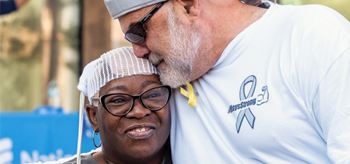A new capital campaign is set to resource a bold approach and major global R&D initiative to cure pediatric brain tumors
WASHINGTON, D.C. & BOSTON, MA – National Brain Tumor Society (NBTS), the largest nonprofit dedicated to the brain tumor community in the United States, today announced the launch of new capital campaign that will fund a major translational research and drug discovery program designed to enable the development of the first-ever standard of care for treating pediatric high-grade gliomas – including diffuse intrinsic pontine gliomas (DIPG) – in order to extend and improve the lives of our youngest and most vulnerable of patients.
The announcement was made by the National Brain Tumor Society and leading pediatric brain tumor experts at an event at the National Press Club in Washington, D.C.
“Project Impact: A Campaign to Defeat Pediatric Brain Tumors” will ultimately resource the Defeat Pediatric Brain Tumor Research Collaborative, a unique approach to conducting scientific research that harnesses the power of a collaborative research platform and infrastructure in order to accelerate the effort to improve clinical outcomes for pediatric brain tumor patients, starting in the area of most urgent need: pediatric high-grade gliomas, including DIPGs, the deadliest pediatric cancers. Monies raised from the capital campaign will go directly into funding the Defeat Pediatric Brain Tumor Research Collaborative, which has been in development with the leading minds in pediatric brain tumor and cancer research since 2014.
Project Impact: A Campaign to Defeat Pediatric Brain Tumors, as a capital campaign, seeks to initially raise at least $2.5 million in specialty gifts over five years to resource the launch of scientific projects within the Defeat Pediatric Brain Tumors Research Collaborative, with an ongoing aim to ultimately invest more than $5 million, from multiple sources, in the program. The St. Baldrick’s Foundation, the largest private funder of childhood cancer research grants, has already made an initial investment in the Collaborative, making them a strategic partner to the Collaborative.
Current market forces create disincentives for investment in pediatric brain tumor drug discovery and development from the biopharmaceutical industry, leaving National Cancer Institute-funded clinical trial networks as the primary source of drug discovery and clinical development in this field. Philanthropic efforts (those by individuals, foundations, and nonprofit/charitable organizations) have tried to infuse resources into the pediatric brain tumor research and drug development field, but these efforts to-date have paled in comparison to fundraising pushes for other more prominent and prevalent diseases, making pediatric brain tumors the dark corner of the oncology world.
This year, more than 4,600 children and adolescents (0-19 years) will be diagnosed with a pediatric brain and central nervous system (CNS) tumor, making these tumors the most prevalent form of pediatric cancer. Unfortunately, these tumors are also the deadliest form of cancer in all children under the age of 14, and second deadliest cancer in all children and adolescents under 19.
Despite these facts, there has never been a drug developed specifically to treat pediatric brain tumors. In fact, there are very few standards of care or treatment options for children with brain tumors. In particular, pediatric high-grade gliomas have no standard of care. Overall, less than 30% of all children with high-grade gliomas survive more than five years. For DIPG, the diagnosis is “uniformly fatal,” and most children only survive nine months, or about as long as the typical school year. Further, because no treatment has been developed specifically with a child’s developing brain in mind, the treatments that are currently used (mainly radiation and chemotherapies) often inflict a lifetime of neurological, cognitive, developmental, and other deficits on the children who do manage to survive their tumor.
Due in large part to difficulties obtaining tissue samples and biospecimens in this field, for many years pediatric neuro-oncologists assumed – and treated – pediatric high-grade gliomas as if their tumor biology was the same as their adult counterpart. However, advances in technology and techniques have enabled more effective collection and analysis of pediatric high-grade glioma tissue samples in recent years. These recent studies have shown that pediatric high-grade gliomas are actually significantly distinct in their biology and molecular make-up from adult high-grade gliomas.
“Treatment of pediatric high-grade gliomas has been extremely frustrating with little progress made over the past quarter century,” said Dr. Roger Packer of Children’s National Health System in Washington, D.C., and Scientific Director of the Defeat Pediatric Brain Tumors Research Collaborative. “New molecular insights provide hope that therapies will be dramatically more effective in the very near future. But we need to maintain forward momentum — from discovering the molecular and genetic underpinnings of these tumors, to understanding how these changes drive these tumors, and to ultimately developing effective, biologically precise therapies. This is a major opportunity for the field, patients and their families.”
The structure of the Defeat Pediatric Brain Tumors Research Collaborative is built to accelerate research from discovery to clinical trials through a platform that fosters collaboration and real-time data, information and material sharing.
“Researching and developing new treatments for pediatric brain tumors is a particularly challenging task, which faces multiple – but interrelated – barriers that span the research and development spectrum from small patient populations, lack of effective preclinical models, to complex basic biology, regulatory hurdles and economic disincentives,” said David Arons, Chief Executive Officer, National Brain Tumor Society. “To overcome these complex challenges, and get better treatments to patients, we needed to create an equally sophisticated intervention. We believe that having groups with complementary skills work together in a coordinated effort, sharing data and expertise, and tackling the problem from multiple angles as one team is the starting point for greater and faster progress.”
The “Defeat” model is defined by two major characteristics:
- A collaborative scientific research structure which consists of multiple interrelated “Cores” that work on critical areas of research simultaneously and share data, information, and materials between them in real-time. The “Cores” design allows new findings in one area of the Collaborative to quickly move on to its next stage of research without barriers or typical delays. The Cores drive toward a molecularly-driven clinical trial platform, which can also send data back into the cores for “reverse translation.”
- A research management model that facilitates all of the Collaborative’s operational and administrative needs so that researchers can spend more time in the lab and less time doing paperwork.
National Brain Tumor Society created a subsidiary, “Pediatric Cancer Cure, LLC,” to govern the Defeat Pediatric Brain Tumors Research Collaborative. Pediatric Cancer Cure, LLC is directed by a Managing Board, and employs a Research Management Organization (RMO), led by a President to oversee the operational needs of the Collaborative. NBTS acts as the RMO and Mr. Arons will serve as the President of the Pediatric Cancer Cure LLC. As RMO, NBTS is responsible for administrative activities of the Collaborative, such as negotiating agreements, managing the budget and finances, managing the IP portfolio, conducting marketing and communications, providing data and infrastructure support, coordinating meetings and research reviews, and driving fundraising efforts. These groups then work with a Strategic Scientific Advisory Council (SSAC), chaired by a Scientific Director, Dr. Packer, which provides oversight to the scientific projects. The Scientific Director is responsible for managing the research portfolio, including developing a Strategic Research Plan, nominating individuals or entities to conduct or support research, and establishing and evaluating annual research milestones.
World-renowned researchers leading each Core with institutional support, include:
- Discovery Core (Molecular Diagnostics & Target Discovery): Stefan Pfister, German Cancer Research Center
- Biomarker Core (Identification & Validation – Tissue & Serum): Nada Jabado, Montreal Children’s Hospital
- Preclinical Modeling & Drug Screening Core: Suzanne Baker, St. Jude Children’s Research Hospital
- Smart Trials (N-of-1 clinical trials): Collaboration with the Pacific Pediatric Neuro-Oncology Consortium
“This deadly disease can only be tackled by a world-wide collaborative effort between dedicated groups focusing on this disease with different expertise, including molecular biology, genetics, preclinical modeling, and clinical trial design,” said Dr. Pfister. “The Defeat Pediatric Brain Tumor Research Collaborative brings these groups together in a unique way, thereby strengthening existing – and fostering novel – scientific and clinical synergies for the benefit of our patients and families.”
Leading the campaign to raise the funds needed to sustainably resource the Defeat Pediatric Brain Tumor Research Collaborative is the Project Impact Steering Committee, made-up of individuals interested in making a greater impact for children with pediatric brain tumors. It is co-chaired by Michael Nathanson, Chairman of the National Brain Tumor Society’s Board of Directors and Chief Executive Officer, President, and Chairman of the Colony Group, a leading independent wealth management company, along with Cord Schlobohm a practicing dentist, and father of a daughter lost to a pediatric high-grade glioma.
In addition to campaign contributions, philanthropic, patient advocacy organizations, foundations, and individuals may join Pediatric Cancer Cure, LLC as Partners, like the St. Baldrick’s Foundation, thereby providing additional financial investment and community engagement. Additionally, Founding Research Collaborators – representing investigators within the Collaborative – provide specific scientific expertise and institutional resources to support the research cores of the Collaborative.



